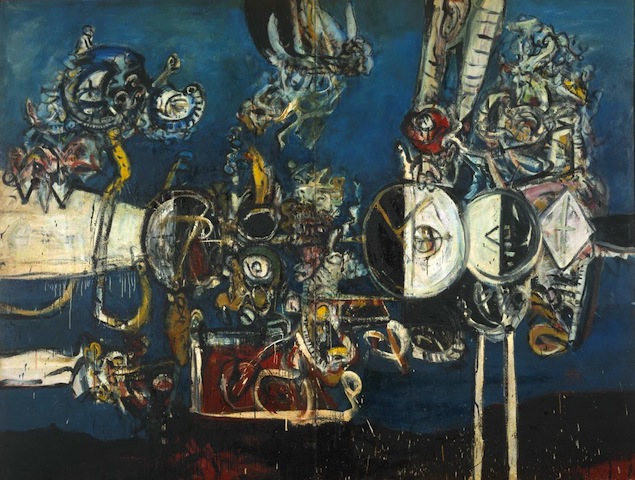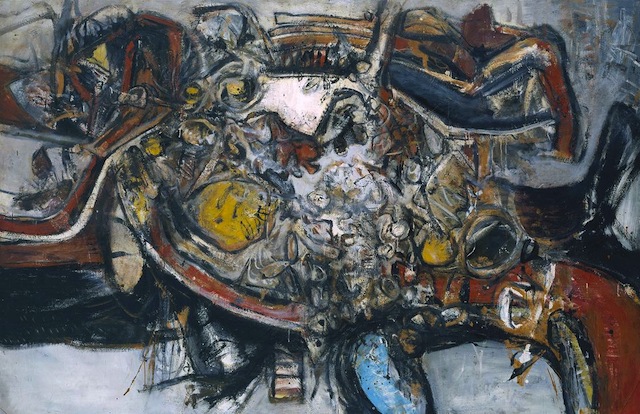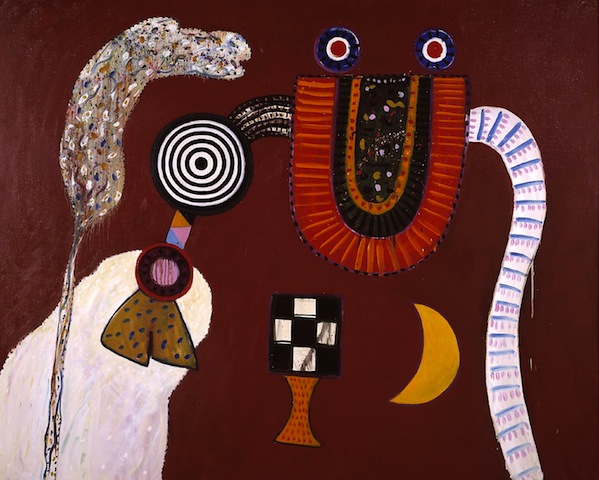Alan Davie, who died on Saturday aged 93, was one of the great 20th-century British artists, a life-long maverick whose explosive canvases cut a swathe through the provincial aridity of the postwar art scene. The first British – probably the first European – artist to become aware of Pollock’s innovations and take on the challenge of “action painting”, the quietly spoken but formidable Scot forged his own expressive path that was less an imitation of Pollock more, as fellow artist Peter Doig put it recently, “like an expanded Paul Klee… but much more physical, much more visceral.”
At the time of his breakthrough Whitechapel Gallery exhibition in 1958, Davie’s improvisatory paintings were as “out there” as British art got. Monumental works such The Creation of Man and Sacrifice, 1956 (pictured below © Tate) mixed an exuberant physicality with an ominous ritualistic quality that made the efforts of the closely related St Ives artists look positively prim in comparison. With his interests in jazz, Zen and chance, his desire to lose himself in the ocean of his own intuitive creativity, Davie was the nearest Britain ever got to producing a Beat artist.
 Yet if his long red beard and quirky humour made him appear something of a wildman, Davie was reserved in a way that could appear arrogant, but masked a profound shyness. Indeed, while he was feted by Pollock, Rothko and Hockney and associated with the pan-European CoBrA movement, Davie wasn’t interested in joining anybody else’s club. He was content to explore the workings of his own mind and creative spirit in a private world that became increasingly removed from the art world mainstream – a propensity that was to be the undoing of his international reputation.
Yet if his long red beard and quirky humour made him appear something of a wildman, Davie was reserved in a way that could appear arrogant, but masked a profound shyness. Indeed, while he was feted by Pollock, Rothko and Hockney and associated with the pan-European CoBrA movement, Davie wasn’t interested in joining anybody else’s club. He was content to explore the workings of his own mind and creative spirit in a private world that became increasingly removed from the art world mainstream – a propensity that was to be the undoing of his international reputation.
At art school the tutors were appalled by his refusal to tow the academic line, but he won every prize going
While arguably less talented peers such as William Scott, Roger Hilton and Peter Lanyon became iconic figures, by the Eighties Davie was nearly forgotten.
The last decade, however, has seen a revival of interest in his work, with prices for early works rocketing. Now Davie can be seen as a great romantic individualist, the best of whose work stands beside anything produced by any British artist of the 20th century.
James Alan Davie was born in Grangemouth, Scotland, in 1920. His father was a teacher and artist of minor repute linked to the Glasgow School; many of his mother’s family were professional musicians. By his own account a solitary child, the young Davie was equally talented in both fields, producing accomplished works in an adult manner, inspired by his father’s books on Holbein, Goya and van Gogh, and teaching himself to play the saxophone after seeing American jazzman Coleman Hawkins playing in a local record shop.
Davie’s self-belief was bolstered by his father’s encouragement of his apparently limitless talents. At art school the tutors were appalled by his refusal to tow the academic line, but he won every prize going. During war service in the Royal Artillery he wrote voluminous amounts of poetry, which his father faithfully typed out and bound in exquisite hand-made books. On demob he became a professional jazz musician, touring as featured tenor sax player with leading Scottish big bands. (Pictured below: Birth of Venus, 1955 © Tate)
But on meeting the love of his life, fellow art student Janet Gaul known as Bili, who he soon married, he jacked it all in and embarked on a romantic journey through Europe, funded by an academic travel scholarship. It was an experience which, through an unlikely chain of occurrences, launched his career as an artist.
At the Venice Biennale, the first since the war, he saw huge exhibitions of Picasso and Klee and the work of the New York painters, which was then barely known in Europe. Davie began painting in earnest, working on big rolls of paper on the floors of cheap hotel rooms. He held exhibitions in Florence and Venice, where he came to the attention of stellar collector Peggy Guggenheim, who was astonished that works of such visceral intensity could have been produced by a British artist.
On Guggenheim’s recommendation, Davie was taken on by Gimpel Fils, then London’s top avant-garde art gallery, though he didn’t sell a single painting during his first seven years with the them. Living in the Abbey Art Centre, a sort of proto-commune in New Barnet, Davie survived by making pre-Columbian-inspired jewellery by day and playing jazz in London clubs by night – while his abstract, yet intensely bodily paintings were resolutely ignored by the British art world. (Pictured below: Fairy Tree, 1971 © Tate)
Yet from the time of his debut New York exhibition at the Catherine Viviano Gallery in 1956, at which every work sold, Davie’s career was on an unstoppable upward trajectory, culminating in his 1958 Whitechapel exhibition.
With their exhilarating colour and joyous, almost childlike exuberance, Davie’s paintings of the Sixties are as representative of the spirit of that tumultuous decade as anything by Hockney or Blake. But tastes in art were changing: expressive abstraction was out. Yet if the focus of the art world had moved away from him, Davie didn’t care – or certainly not initially. Still exhibiting and selling, with homes in Hertfordshire, Cornwall and St Lucia, he was happy to plough his own furrow in works that became less improvisatory, more structured and drew increasingly on non-European art – African, Indian, Aboriginal, Native American – of which he had a superb collection.
While this drew criticism that he absorbed every culture except his own, he was also fascinated by western Outsider Art, graffiti and tattoos. Indeed, in his final years, he came to see himself increasingly as an outsider artist, a unique figure who was beyond the boundaries of the Western mainstream.
This self-assessment was in some ways accurate: for Davie art was an involuntary, biological urge, something he felt impelled to do regardless of other people’s tastes or opinions. And yet at the same his work represents a vital moment in the development of international art, a kind of psychic opening-out after the trauma of the Second World War, an embracing of new possibilities and new freedoms, a global mood that is best expressed – certainly in British art – in the work of Alan Davie.
BP Spotlight: Alan Davie at Tate Britain from 14 April to 28 September
Alan Davie: The Symbol is Neither Rational nor Concrete at Gimpel Fils, London, from 24 April to 23 May
Alan Davie: The (Wild) Eye of Wonder. Early Paintings 1945-1970 at Alan Wheatley, London, from 9 April to 23 May










![SEX MONEY RACE RELIGION [2016] by Gilbert and George. Installation shot of Gilbert & George 21ST CENTURY PICTURES Hayward Gallery](/sites/default/files/styles/thumbnail_125_x_125_/public/mastimages/Gilbert%20%26%20George_%2021ST%20CENTURY%20PICTURES.%20SEX%20MONEY%20RACE%20RELIGION%20%5B2016%5D.%20Photo_%20Mark%20Blower.%20Courtesy%20of%20the%20Gilbert%20%26%20George%20and%20the%20Hayward%20Gallery._0.jpg?itok=3oW-Y84i)




Add comment